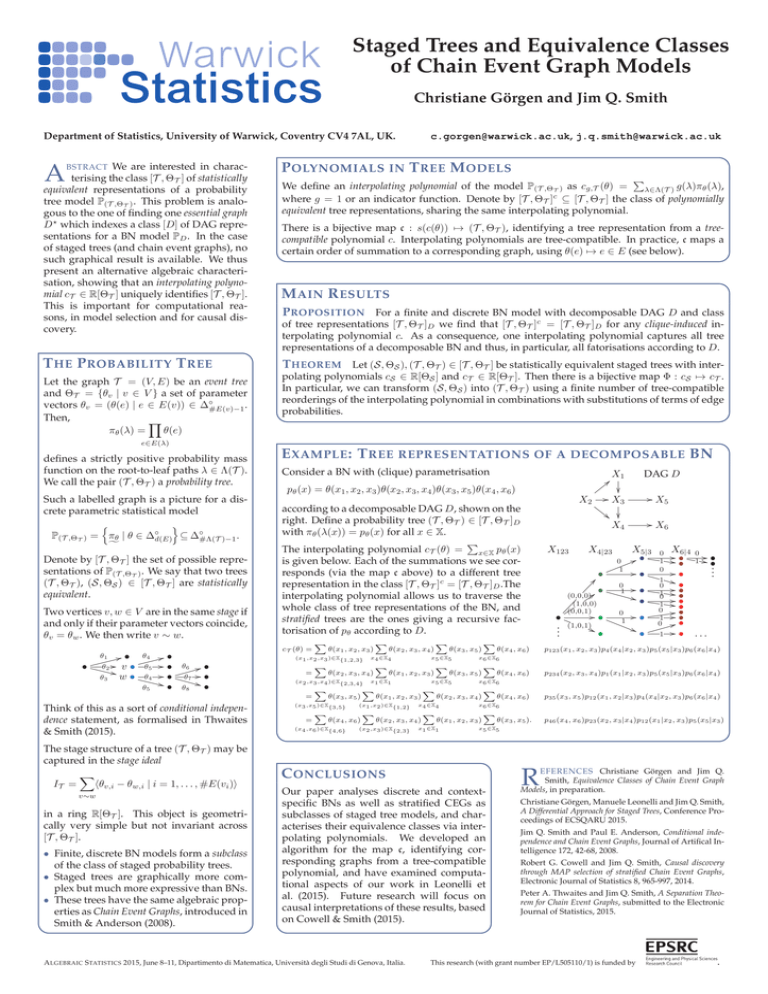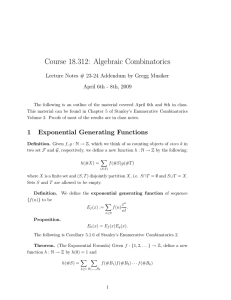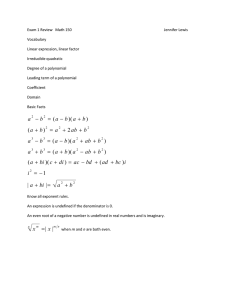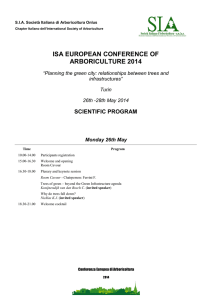Staged Trees and Equivalence Classes of Chain Event Graph Models
advertisement

Staged Trees and Equivalence Classes
of Chain Event Graph Models
Christiane Görgen and Jim Q. Smith
Department of Statistics, University of Warwick, Coventry CV4 7AL, UK.
c.gorgen@warwick.ac.uk, j.q.smith@warwick.ac.uk
We are interested in characterising the class [T , ΘT ] of statistically
equivalent representations of a probability
tree model P(T ,ΘT ) . This problem is analogous to the one of finding one essential graph
D? which indexes a class [D] of DAG representations for a BN model PD . In the case
of staged trees (and chain event graphs), no
such graphical result is available. We thus
present an alternative algebraic characterisation, showing that an interpolating polynomial cT ∈ R[ΘT ] uniquely identifies [T , ΘT ].
This is important for computational reasons, in model selection and for causal discovery.
P OLYNOMIALS IN T REE M ODELS
T HE P ROBABILITY T REE
T HEOREM Let (S, ΘS ), (T , ΘT ) ∈ [T , ΘT ] be statistically equivalent staged trees with inter-
A
BSTRACT
Let the graph T = (V, E) be an event tree
and ΘT = {θv | v ∈ V } a set of parameter
vectors θv = (θ(e) | e ∈ E(v)) ∈ ∆◦#E(v)−1 .
Then,
Y
πθ (λ) =
θ(e)
P
We define an interpolating polynomial of the model P(T ,ΘT ) as cg,T (θ) =
λ∈Λ(T ) g(λ)πθ (λ),
where g = 1 or an indicator function. Denote by [T , ΘT ]c ⊆ [T , ΘT ] the class of polynomially
equivalent tree representations, sharing the same interpolating polynomial.
There is a bijective map c : s(c(θ)) 7→ (T , ΘT ), identifying a tree representation from a treecompatible polynomial c. Interpolating polynomials are tree-compatible. In practice, c maps a
certain order of summation to a corresponding graph, using θ(e) 7→ e ∈ E (see below).
M AIN R ESULTS
P ROPOSITION For a finite and discrete BN model with decomposable DAG D and class
of tree representations [T , ΘT ]D we find that [T , ΘT ]c = [T , ΘT ]D for any clique-induced interpolating polynomial c. As a consequence, one interpolating polynomial captures all tree
representations of a decomposable BN and thus, in particular, all fatorisations according to D.
polating polynomials cS ∈ R[ΘS ] and cT ∈ R[ΘT ]. Then there is a bijective map Φ : cS 7→ cT .
In particular, we can transform (S, ΘS ) into (T , ΘT ) using a finite number of tree-compatible
reorderings of the interpolating polynomial in combinations with substitutions of terms of edge
probabilities.
e∈E(λ)
defines a strictly positive probability mass
function on the root-to-leaf paths λ ∈ Λ(T ).
We call the pair (T , ΘT ) a probability tree.
Such a labelled graph is a picture for a discrete parametric statistical model
n
o
P(T ,ΘT ) = πθ | θ ∈ ∆◦d(E) ⊆ ∆◦#Λ(T )−1 .
f
Denote by [T , ΘT ] the set of possible representations of P(T ,ΘT ) . We say that two trees
(T , ΘT ), (S, ΘS ) ∈ [T , ΘT ] are statistically
equivalent.
Two vertices v, w ∈ V are in the same stage if
and only if their parameter vectors coincide,
θv = θw . We then write v ∼ w.
θ1
•
θ2
θ3
3•
/ v•
+
w•
θ4
θ5
θ4
θ5
3•
/•
/•
+•
E XAMPLE : T REE REPRESENTATIONS OF A DECOMPOSABLE BN
Consider a BN with (clique) parametrisation
pθ (x) = θ(x1 , x2 , x3 )θ(x2 , x3 , x4 )θ(x3 , x5 )θ(x4 , x6 )
cT (θ) =
θ6
θ7
θ8
4•
/•
*•
The stage structure of a tree (T , ΘT ) may be
captured in the stage ideal
X
IT =
hθv,i − θw,i | i = 1, . . . , #E(vi )i
v∼w
in a ring R[ΘT ]. This object is geometrically very simple but not invariant across
[T , ΘT ].
• Finite, discrete BN models form a subclass
of the class of staged probability trees.
• Staged trees are graphically more complex but much more expressive than BNs.
• These trees have the same algebraic properties as Chain Event Graphs, introduced in
Smith & Anderson (2008).
X
θ(x1 , x2 , x3 )
(x1 ,x2 ,x3 )∈X{1,2,3}
=
X
X
θ(x3 , x5 )
(x3 ,x5 )∈X{3,5}
=
X
θ(x2 , x3 , x4 )
X
θ(x3 , x5 )
X
x6 ∈X6
X
X
X
θ(x1 , x2 , x3 )
x1 ∈X1
X
X
x5 ∈X5
θ(x1 , x2 , x3 )
X
X
A•
:•
•
..
.
θ(x4 , x6 )
x6 ∈X6
X
X
θ(x1 , x2 , x3 )
(0,0,0)
(1,0,0)
(0,0,1)
/•
(1,0,1)
(•
0
1
X5|3
6•
/•
0
1
0
1
/•
*•
/•
(•
0
1
0
1
0
1
0
1
0
1
0
1
X6|4 0
-/ •• 1 /,
/•
*•
/- •
/- ••
1/ ••
4 ••
/ • ...
•
•.
..
p123 (x1 , x2 , x3 )p4 (x4 |x2 , x3 )p5 (x5 |x3 )p6 (x6 |x4 )
p234 (x2 , x3 , x4 )p1 (x1 |x2 , x3 )p5 (x5 |x3 )p6 (x6 |x4 )
θ(x3 , x5 ).
p35 (x3 , x5 )p12 (x1 , x2 |x3 )p4 (x4 |x2 , x3 )p6 (x6 |x4 )
p46 (x4 , x6 )p23 (x2 , x3 |x4 )p12 (x1 |x2 , x3 )p5 (x5 |x3 )
x5 ∈X5
C ONCLUSIONS
Our paper analyses discrete and contextspecific BNs as well as stratified CEGs as
subclasses of staged tree models, and characterises their equivalence classes via interpolating polynomials. We developed an
algorithm for the map c, identifying corresponding graphs from a tree-compatible
polynomial, and have examined computational aspects of our work in Leonelli et
al. (2015). Future research will focus on
causal interpretations of these results, based
on Cowell & Smith (2015).
A LGEBRAIC S TATISTICS 2015, June 8–11, Dipartimento di Matematica, Università degli Studi di Genova, Italia.
X4|23
/ X6
x6 ∈X6
θ(x2 , x3 , x4 )
x1 ∈X1
X123
θ(x4 , x6 )
x4 ∈X4
θ(x2 , x3 , x4 )
(x2 ,x3 )∈X{2,3}
θ(x3 , x5 )
/ X5
! X4
θ(x4 , x6 )
x5 ∈X5
(x1 ,x2 )∈X{1,2}
θ(x4 , x6 )
(x4 ,x6 )∈X{4,6}
X
x4 ∈X4
θ(x2 , x3 , x4 )
(x2 ,x3 ,x4 )∈X{2,3,4}
=
Think of this as a sort of conditional independence statement, as formalised in Thwaites
& Smith (2015).
X2
according to a decomposable DAG D, shown on the
right. Define a probability tree (T , ΘT ) ∈ [T , ΘT ]D
with πθ (λ(x)) = pθ (x) for all x ∈ X.
P
The interpolating polynomial cT (θ) = x∈X pθ (x)
is given below. Each of the summations we see corresponds (via the map c above) to a different tree
representation in the class [T , ΘT ]c = [T , ΘT ]D .The
interpolating polynomial allows us to traverse the
whole class of tree representations of the BN, and
stratified trees are the ones giving a recursive factorisation of pθ according to D.
DAG D
= X1
/ X3
R
EFERENCES Christiane Görgen and Jim Q.
Smith, Equivalence Classes of Chain Event Graph
Models, in preparation.
Christiane Görgen, Manuele Leonelli and Jim Q. Smith,
A Differential Approach for Staged Trees, Conference Proceedings of ECSQARU 2015.
Jim Q. Smith and Paul E. Anderson, Conditional independence and Chain Event Graphs, Journal of Artifical Intelligence 172, 42-68, 2008.
Robert G. Cowell and Jim Q. Smith, Causal discovery
through MAP selection of stratified Chain Event Graphs,
Electronic Journal of Statistics 8, 965-997, 2014.
Peter A. Thwaites and Jim Q. Smith, A Separation Theorem for Chain Event Graphs, submitted to the Electronic
Journal of Statistics, 2015.
This research (with grant number EP/L505110/1) is funded by
.



